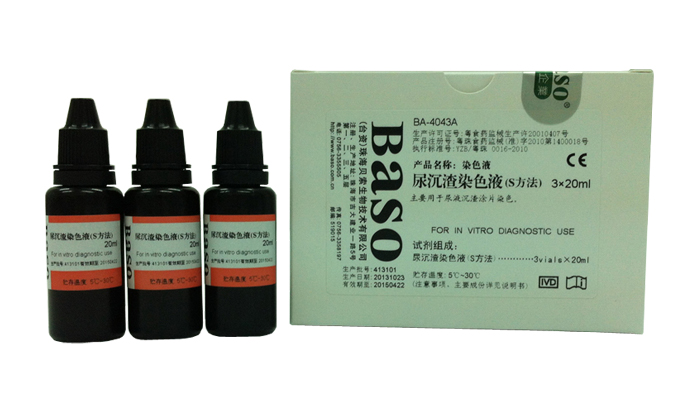Urinary Sediment Stain (Modified S&M)

Intended use:
Urinary analysis is one of the three routines in clinical examination and widely used in clinic. Urinary sediment test, as the most common examination for urinary analysis, is mainly used to identify pathological components in urine including cells, casts, crystal, bacteria and parasites. It is of great value for diagnosis, orientation, identification and prognosis estimation of urinary system disease.
Principle:
SM Urinary sediment stain is the most widely-used method. Directly add stain into urinary sediment, and the components in urinary sediment can be easily identified based on their distinct shape and structure. Compared with the traditional SM stain, this modified BASO Urinary sediment stain offers the benefits of shorter staining time and longer storage stability at room temperature.
Specifications:
| Contents | 3vialsx20ml/kit | Components |
| Urinary sediment stain | 20ml | Pyronine B, Ammonium Oxalate, Ethanol, Alcian Blue |
Precaution:
1. Urinary specimen must be fresh and morning urine isthe best. Specimen should be tested within 1 hour after
collection. Otherwise, add formaldehyde to the specimen and store at 4℃until testing.
2. If urine is alkalescent, adjust to slight acidic with 1% acetic acid to clear phosphate away. Care should be
taken not to add toomuch acid, or else erythrocytes and casts will be dissolved.
3. Prior to urine collection, it is very important to ensure that patients follow proper fasting procedure (for
example, no drinking water during specimen collection), or else urine will be diluted and results not
reliable. For adult women, their pudendum should be cleaned before collection. It ispreferred to collect
the mid-stream of urine sample in order to avoid introducing any pudendum and castoff cells from the
vagina.
4. The staining time should be adequate. If stain for too long, the lightly stained cells can become overstained.
5. For bilirubin urine, its tangible components can bestained yellow that masks their true color. In addition, the
pigment granules of stain may also be mistaken as components of urinary sediment. Hence, it is important to
differentiate all components carefully to avoid any misidentification.


